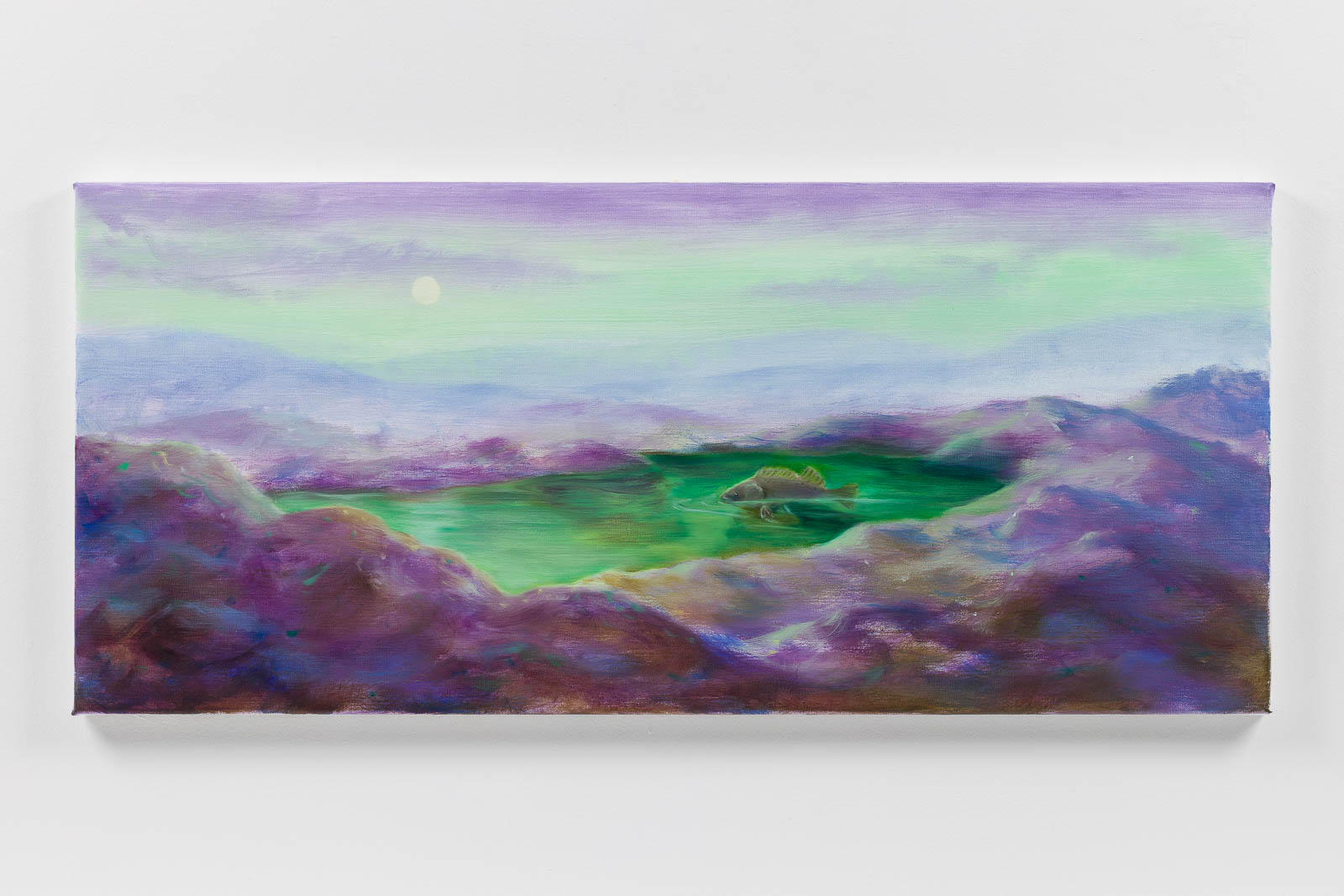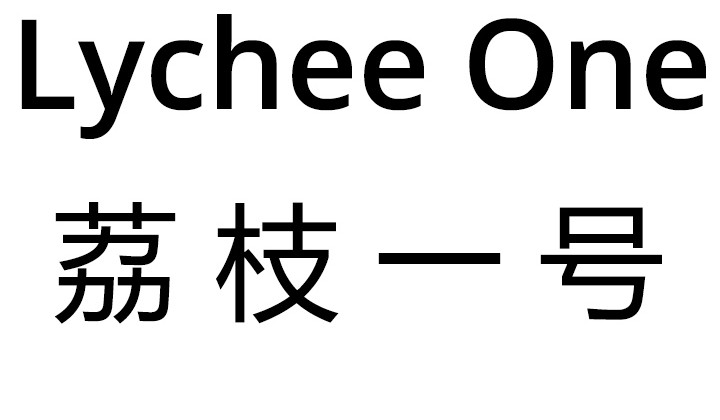Distant Night
Minyoung Choi
13th March – 12th April 2025
Opening 13th March, 18:00 – 20:30

Minyoung Choi, Pool, 2025, Oil on linen, 40 x 90 cm
THE WEIRDLY DISTANT: MINYOUNG CHOI’S PAINTINGS
“Are we being watched by an entity that has not revealed itself to us?”
Mark Fisher, ‘The Weird and the Eerie” (2016)
Minyoung Choi’s paintings are pictures of places that are somewhere else. It is not possible to locate or date these scenes; we could be looking at the past, the present or the future. Or they could also easily be an alternate past, an adjacent present or a substituted future. We are looking into, through and over a place that is both particular and yet unremarkable. It may be a domestic setting, such as a bathroom bathed in fluorescent light. It may be a snowy nocturne where stillness has been disturbed by a duo of play-fighting lynx.
In many of the paintings, it is night-time. We are outdoors or at the edge of it. There is terrain and sky, a ground in front and an expanse above. Something is occurring. Snow leopards, lynx, catfish modestly populate the paintings. Occasionally, there may be a person depicted, but they often have a secondary or supporting role in Choi’s paintings; the animals of the natural world are prioritised. These creatures may be in their native habitat where they are unbound to freely roam and drift; a snow leopard ambling across a snowy plain at night. Elseways, it may be an unnatural habitat where they are fettered, and their freedom is curtailed; an out of water fish seen wedged on a rock unable to reach the water’s surface below. Could it be that the animals are metaphors for us? Should we see ourselves in them? Were they once us but have metamorphosed into big cats and at the behest of some unseen entity?
There is the intimation of a quasi-narrative that is playing out across the paintings. At first, each work appears to represent an isolated moment. These moments are not necessarily exceptional in their description, but are customary and habitual, verging on the prosaic. The daily ritual of hunting for food or burning incense. Cyclical. An extreme analogy could be a kind of wildlife soap opera with its anticipated portrayal of the routine and the recognisable, but where artifice and incongruence irritate at the periphery. With these pictures, we are given the minimal of strangeness through the maximal of the ordinary as, while the paintings gently brush against surrealism, they also persist in denying its usual absurdist dream logic.
But the paintings still subtly unsettle and displace us. The colour is exaggeratedly saturated whilst still being more or less faithful and contiguous to the material world as we know it. This is not a world of greys and browns, but of unwavering purples, blues and greens. It feels altered, just as one may adjust the brightness and saturation of their display, the colour in these paintings has been retuned. Turned on. Naturally unnatural. An incompatible scaling is another way the paintings gently deceive us; animals are described much larger or smaller than one would expect – sometimes it’s difficult to know exactly which, as they can feel gigantic in one instant and then miniscule the next. Each of the characters, along with the nearby inanimate motifs, such as trees and mountains, are deposited into the composition, becoming staged and lit up so as to ensure a pictorial equilibrium. In that respect, there is as much an absorption with picture-making as there is with story-telling.
Choi’s recent works have a different character to how the paint has been handled. Although they are doubtlessly fictitious, they now have the look of paintings made from life rather than
imagined, where there has been a greater urgency and agency to capture the phenomena before it changes. This urgency contradicts the relatively serene and uneventful scenes but very much relates to the dimensions of the paintings themselves, which are smaller in size than Choi usually makes. This reduction has led to less definition in how crystalline the animals and the landscapes are when compared to her earlier work. These smaller pictures are more like impressions and approximations rather than fully realised and lucidly evinced tableaux.
Scale and depth are also important when thinking about how skies are always present. In the most recent work, Choi is concentrating specifically on the night sky, which is quite a different proposition to the sky we encounter during the day. A sky at night underscores the notion of a pictorial distancing, of the farthest away points we can imagine, not only something that is outwith our physical, bodily reach but which is beyond the comprehension of our human- scaled anthropocentric concerns. Whilst nightfall shrouds the world in a blanket of darkness, it also divulges a different view of our world and our place in it. A belonging and an unbelonging are part of the mechanics of the paintings. What kind of environment do we each belong in? What do we need to survive? In that way, Choi’s work may be connected to ‘unwelt’, a term denoting how animals have their own distinct means of processing sensory information from their surroundings. And whilst those inside the paintings have the capacity to engage the breadth of their senses, all that we are left to do is look on in passivity as witnesses to these encounters.
The writer and philosopher Henry David Thoreau wrote in August 1851: “The question is not what you look at, but what you see.” An awareness of seeing and of being seen is steadily evoked in the work. We all are observed at some point, with or without our realisation; perhaps we are being observed at this very moment. In ‘Bath’, the fake eyelashes on the counter could just as easily be a pair of tightly closed eyes rather than an idle make-up accessory, and so, the ability for the painting to look back at us has been revoked. Whatever is occurring in the paintings, it feels weirdly distant to us. We feel as if we are looking through a glass window or watching a monitor screen. Or possibly even looking at a representation of the scene rather than the scene itself. The ‘fourth wall’ has not been broken but has been re- established and validated. Choi is not painting an immediate space that belongs to those ‘on the outside’ as it were. It is that ‘somewhere-else’ place that we can only be temporarily accessed through the imagination and, by extension, through the making of – and the looking at – painting.
Text by Scott McCracken
ARTIST BIOGRAPHY
Minyoung Choi (b. Seoul, South Korea, 1989) is an artist who focuses primarily on oil painting. She graduated from the MFA Painting Course at the Slade School of Fine Art in 2017 and is currently living and working in London. She completed her BFA (2007 – 2010) and MFA (2011 – 2013) in Painting at Seoul National University in Seoul, South Korea before moving to London.
Choi’s works, which straddle the boundary between surrealism and real life representations, often function in relation to one another as a series of meditations on a particular theme or concept. Objects, images and patterns of light frequently recur among her paintings, creating a sense of cohesion, as if these pictures all belonged to the same dusky, strangely lit dream. Light is of utmost importance to Minyoung’s pictures, its various, radiating sources – moon, sunset, laptop screen, lamp – often providing the focal point of the composition.
Selected solo/duo show include:(upcoming) Distant Night, Lychee One, London (UK) 2025; 꿈을 빌려드립니다 | Dreams for Hire, Space K Seoul 2024; Dark Brightness, Hive Center for Contemporary Art, Beijing (CN) 2023; Tangent Worlds, Galeria Pelaires_Cabinet, Palma de Mallorca (ES) 2023; Always there, Lychee One, London, 2022; Things That Happen When We Are Not Looking, Lychee One, London, 2021; In Conversation: Part II, Duo Show with Mircea Teleagă, curated by bo.lee Gallery, Copeland Gallery, London; MINYOUNG CHOI, Andelli Art Gallery, Wells, Somerset (2019); On Water Under Snow, Art in the Bar, Chapter Arts Centre, Cardiff, Wales (2017); Avanzamos / Volvemos, Olvera Contemporary Art Centre, Olvera, Spain (2017).
Choi has been awarded numerous prizes among which the Next Generation Art Prize, part of the Wells Art Contemporary Award in 2018, the Henry Tonks Prize in 2017, the Slade Summer School Residency in 2017 and the Olvera Contemporary Arts Centre Residency in Olvera, Spain in 2017. She was a finalist of the RBA Rising Stars in 2019, the Gilchrist-Fisher Award in 2018 and the Chadwell Award in 2017. Choi’s works have recently been featured in The Economist: Creatures of the shallows-Minyoung Choi’s fish are symbols of confinement, 2021.
PUBLIC COLLECTIONS
EF Education First Art Collection, London (UK) and Zurich (CH)
HSBC Art Collection, London (UK)
Sixi Museum, Nanging (CN)
Soho House Collection, Soho Works Shoreditch, London (UK)
X Museum, Beijing (CN)
